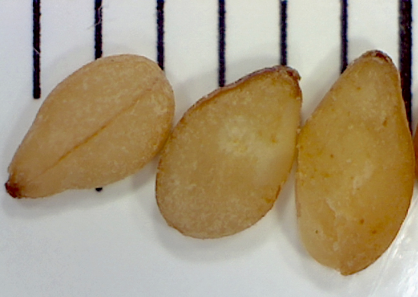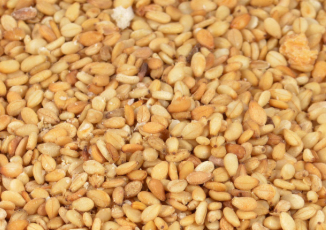| "Descrizione" by Ottika11 (2062 pt) | 2023-Mar-09 10:43 |
Review Consensus: 9 Rating: 9 Number of users: 1
| Evaluation | N. Experts | Evaluation | N. Experts |
|---|---|---|---|
| 1 | 6 | ||
| 2 | 7 | ||
| 3 | 8 | ||
| 4 | 9 | ||
| 5 | 10 |
Sesamum indicum seed oil is an oil derived from the Sesame plant (Sesamum indicum L.), an oil crop with a high oil content. Sesame seeds contain 55-58% oil and almost 18% protein, lignans that enhance the antioxidant action of vitamin E, tocopherols and phenolic components.

In the production process, the seeds are ground and heated to a temperature of up to 90°C. The mince is boiled in water for a quarter of an hour and then cooled. After cooling, the top layer of oil is separated. 1 kg of seeds yields approximately 215 ml.
What it is used for and where

Medical
Sesame oil has the ability to inhibit the growth of the mycelial form of oral candidiasis or oral thrush (Candida albicans) caused by decreased saliva secretion especially in the elderly population (1).
Sesame oil is cheaper than chlorhexidine and can be used as a preventive home therapy to maintain oral hygiene by reducing colonies of aerobic microorganisms in dental plaque.
Sesame oil is cheaper than chlorhexidine and can be used as a preventive home therapy to maintain oral hygiene by reducing colonies of aerobic microorganisms in dental plaque.
Cosmetics
Moisturising and conditioning agent for the skin.
Fragrance. It plays a decisive and important role in the formulation of cosmetic products as it provides the possibility of enhancing, masking or adding fragrance to the final product, increasing its marketability. The consumer always expects to find a pleasant or distinctive scent in a cosmetic product.
Hair conditioning agent. A significant number of ingredients with specific and targeted purposes may co-exist in hair shampoo formulations: cleansers, conditioners, thickeners, matting agents, sequestering agents, fragrances, preservatives, special additives. However, the indispensable ingredients are the cleansers and conditioners as they are necessary and sufficient for hair cleansing and manageability. The others act as commercial and non-essential auxiliaries such as: appearance, fragrance, colouring, etc. Hair conditioning agents have the task of increasing shine, manageability and volume, and reducing static electricity, especially after treatments such as colouring, ironing, waving, drying and brushing. They are, in practice, dispersants that may contain cationic surfactants, thickeners, emollients, polymers. The typology of hair conditioning agents includes: intensive conditioners, instant conditioners, thickening conditioners, drying conditioners. They can perform their task generally accompanied by other different ingredients.
Skin conditioning agent. It is the mainstay of topical skin treatment as it has the function of restoring, increasing or improving skin tolerance to external factors, including melanocyte tolerance. The most important function of the conditioning agent is to prevent skin dehydration, but the subject is rather complex and involves emollients and humectants that can be added in the formulation.
Skin conditioning agent - Emollient. Emollients have the characteristic of enhancing the skin barrier through a source of exogenous lipids that adhere to the skin, improving barrier properties by filling gaps in intercorneocyte clusters to improve hydration while protecting against inflammation. In practice, they have the ability to create a barrier that prevents transepidermal water loss. Emollients are described as degreasing or refreshing additives that improve the lipid content of the upper layers of the skin by preventing degreasing and drying of the skin. The problem with emollients is that many have a strong lipophilic character and are identified as occlusive ingredients; they are oily and fatty materials that remain on the skin surface and reduce transepidermal water loss. In cosmetics, emollients and moisturisers are often considered synonymous with humectants and occlusives.
Pharmaceuticals
Drug delivery vehicle
Other uses
Paints, insecticides
For more information:
Sesamum indicum seed oil, studies
References_____________________________________________________________________
(1) Ogawa T, Nishio J, Okada S. Effect of edible sesame oil on growth of clinical isolates of Candida albicans. Biol Res Nurs. 2014 Jul;16(3):335-43. doi: 10.1177/1099800413501539.
| Evaluate |

